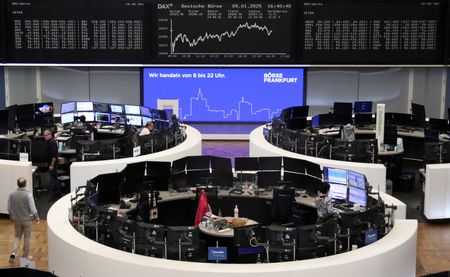By Caroline Valetkevitch
NEW YORK (Reuters) – Profit growth for U.S. corporations is expected to slow next year after a gangbuster 2021, with rising inflation and a rapidly spreading COVID-19 variant adding to uncertainty as investors try to justify stock prices trading near record highs.
The S&P 500 is on track to rise about 24% this year, and the index’s price-to-earnings ratio sits well above its long-term average, raising worries the market may be overbought.
S&P 500 earnings are seen up about 8% in 2022 after an estimated 50% jump this year, when companies rebounded from lockdowns and recession in the early stages of the pandemic, according to IBES data from Refinitiv.
Wall Street’s 2022 consensus estimates have changed little in recent weeks even as stock indexes have lost ground amid worries over how quickly the Omicron variant is spreading.
“We are moving into an environment where we’re likely to go from seeing multiple expansion to multiple compression,” said Robert Phipps, a director at Per Stirling Capital Management in Austin, Texas, referring to a company’s earnings rising but its share price not following suit, leaving investors with little reward.
The forward price-to-earnings ratio for the S&P 500 is at 21.5, compared with its long-term average of 15.5, according to Refinitiv DataStream.
A key factor helping to support valuations has been ultra low interest rates, which is likely to change now that the Federal Reserve is becoming more hawkish with inflation worries rising, Phipps said.
Rising interest rates increase borrowing costs for businesses and consumers, while higher rates also can depress stock multiples, especially for technology and other growth stocks.
The tightening labor market and strengthening economy pushed the Fed last week to announce that it would end its pandemic-era bond purchases in March. That could open the door for three quarter-percentage-point interest rate increases by the end of 2022.
Fed policymakers also forecast that inflation would run at 2.6% next year, above the 2.2% they projected in September.
At the same time, companies are still battling supply disruptions due to the pandemic, which appears to be entering a new, heightened phase as Omicron cases surge across the globe.
The possibility of faster spread and renewed restrictions loomed large in some countries ahead of the holidays. Since the start of the month, U.S. COVID cases have risen 50%, according to a Reuters tally.
“You do have a lot of things that can go wrong,” said Christopher Harvey, head of U.S. equity strategy at Wells Fargo Securities, which sees increased chances for a roughly 10% market decline by next summer.
U.S. companies this year managed to keep profit margins up because they have cut costs and passed along high prices to customers.
It is unclear, however, how much the latest risks will change 2022 earnings estimates and results.
Estimated 2022 S&P 500 earnings growth was at 8.3% as of Friday, compared with 8.0% at the start of December, according to Refinitiv data.
“Earnings estimates are actually going up in December, so Omicron is not even factored into the estimates at this point,” said Nick Raich, CEO of independent research firm The Earnings Scout.
(Reporting by Caroline Valetkevitch; Editing by Alden Bentley)











